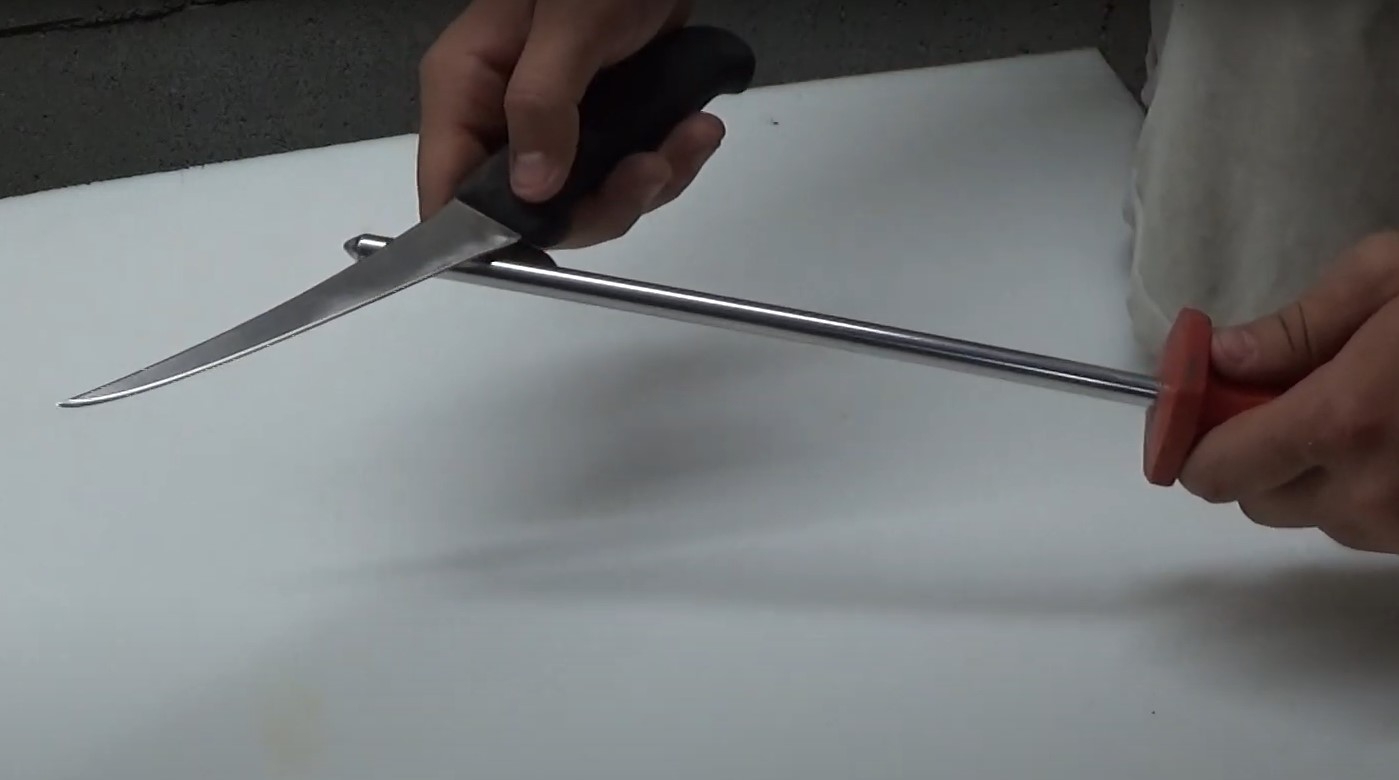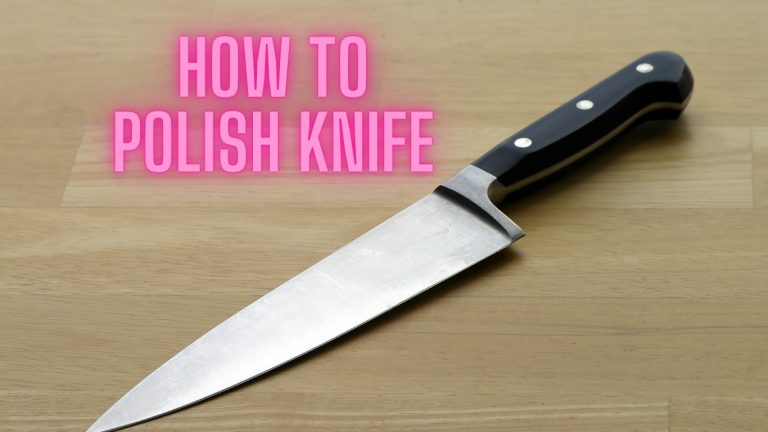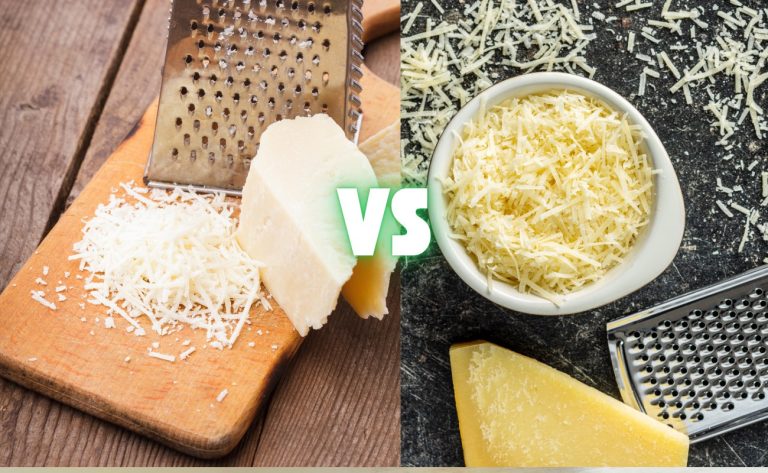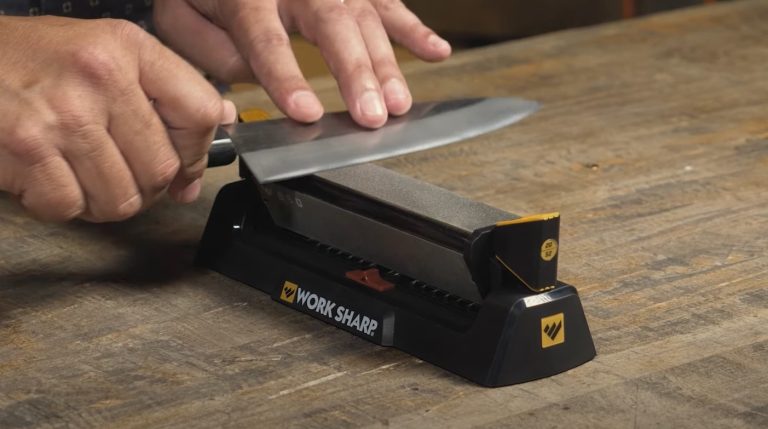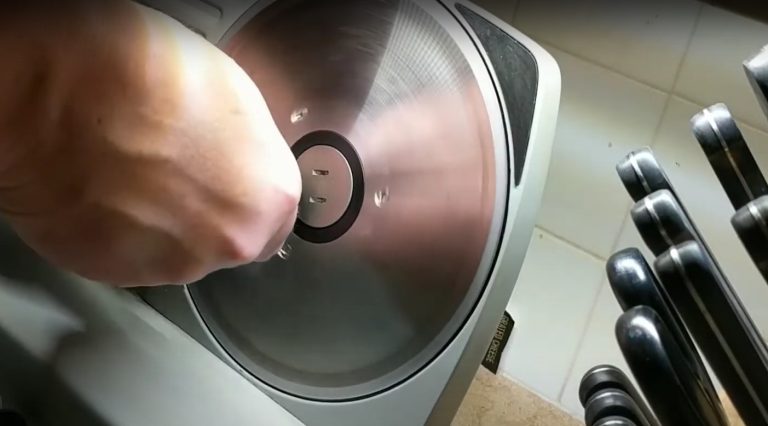How to Use a Butcher’s Steel: Effortless Knife Sharpening
To use a butcher’s steel, hold it vertically with the tip on a stable surface. Position your knife at a 15° to 22° angle, and glide the blade from heel to tip along the steel, applying light pressure.
Make multiple strokes on each side of the blade for ideal alignment. Hone your knife frequently, especially after each use, to keep the edge sharp.
For further insights on techniques and maintenance, continue exploring more tips.
Key Takeaways
- Hold the butcher’s steel vertically, with the tip resting on a stable surface, and maintain a consistent angle of 15° to 22° with the knife.
- Glide the knife blade along the steel from heel to tip in long, even strokes, applying light to moderate pressure as needed.
- Alternate sides with each stroke to ensure even honing, typically performing 5-10 strokes per side to maintain alignment and sharpness.
- Use regular honing after each use to keep the knife edge aligned and prolong its lifespan, especially for frequently used knives.
- Clean the butcher’s steel with hot, soapy water after use and dry immediately to prevent rust and maintain its effectiveness.
Understanding Butcher’s Steel
Butcher’s steel is an important tool for anyone serious about maintaining knife sharpness in the kitchen or butcher shop. This tool hones knives by realigning the edge rather than sharpening them, which removes metal.
Typically made from hardened steel, ceramic, or diamond, butcher’s steels come in various designs, featuring a central tapered rod with a handle. Their primary purpose is to remove burrs and align the microscopic teeth on a knife’s edge, enhancing cutting efficiency.
Regularly honing your knife with a butcher’s steel helps maintain knife sharpness and ensures that it performs optimally during cutting tasks. Properly maintained knives not only enhance safety in the kitchen but also improve overall culinary performance.
While some steels have grooves to provide additional abrasion, all are harder than the knife blade to guarantee effective honing.
Choosing the Right Butcher’s Steel for Your Needs
When it comes to honing your knives effectively, selecting the right butcher’s steel is essential for achieving ideal results.
Consider the material first: steel rods are versatile, while ceramic rods suit ultra-hard blades, and diamond-coated rods are ideal for fast material removal. Regular sharpening is key to maintaining the effectiveness of your knives, regardless of the type of butcher’s steel you choose.
Selecting the right material is crucial: steel for versatility, ceramic for ultra-hard blades, and diamond-coated for quick sharpening.
Next, think about rod shape; rounded rods are lightweight, oval rods offer more control, and flat rods provide a larger contact surface.
Size matters too choose a rod at least an inch longer than your longest knife for safety and effectiveness.
Types of Butcher’s Steels
There are several types of butcher’s steels available, each designed for specific honing and sharpening tasks. Steel rods are common for general sharpening, available in various grits. If you’re working with ultra-hard blades, consider ceramic steels for precise honing.
For quick restoration of dull edges, diamond steels are the hardest and most abrasive option. While titanium steels aren’t as common, they can be found in some specialized sharpening ranges. Standard cut steels are typically used in butchering and commercial kitchens due to their coarse grit.
You’ll also find different profiles, such as round, oval, and square, each offering unique sharpening effects to suit your knife maintenance needs effectively. Traditional steels are particularly useful for aligning knife edges and maintaining sharpness.
Preparing Your Knife for Use
Before you start using your knife, it’s essential to verify it’s properly prepared for maximum performance.
First, make certain your knife is sharpened on a whetstone, as this provides the initial edge necessary for effective cutting. Regularly honing with a butcher’s steel will help maintain that sharpness by realigning the edge.
Using a knife sharpening steel is an effective way to revive the knife edge after cutting, slicing, or chopping. Additionally, proper sharpening angles are crucial for maximizing your knife’s efficiency and longevity.
Ensure your knife is sharpened on a whetstone for an effective cutting edge, and maintain sharpness by honing regularly with a butcher’s steel.
Always hold the knife away from your body to avoid accidents. If your knife is severely dull or damaged, it may require sharpening on a stone instead of just honing.
The Correct Angle for Effective Use
To effectively use a butcher’s steel, you need to understand the knife edge bevel angle, which typically falls between 15 and 22 degrees.
Consistent stroke technique is essential for maintaining the blade’s sharpness, while adjusting the angle might be necessary for different blade types.
Regular honing maintenance can significantly prolong the life of your knife edges. Maintaining the correct sharpening angle is crucial for maximizing knife performance.
Knife Edge Bevel Angle
Choosing the correct knife edge bevel angle is essential for ideal cutting performance. The bevel angle determines your knife’s sharpness and durability, so finding the right balance is vital.
Different knives require varying angles based on their intended use and the materials they’re designed to cut. For instance, Japanese knives typically feature a 15 to 20-degree angle for precision, while Western knives are often sharpened to around 20 degrees for durability.
If you’re working with harder materials, a higher angle may be necessary to prevent chipping. Regular maintenance through sharpening and honing helps keep your knives at their best bevel angle, ensuring they perform effectively whenever you need them.
Additionally, the optimal bevel angle can vary based on the usage context of the knife, influencing the choice between sharpness and edge durability.
Consistent Stroke Technique
Maintaining the correct knife edge bevel angle is just the starting point; mastering consistent stroke technique is key to effective honing with a butcher’s steel.
Focus on these essential aspects for ideal results:
- Stroke Direction: Move the knife from the heel to the tip in a slicing motion, ensuring you follow the natural curve of the blade.
- Stroke Pressure: Apply light to medium pressure; this prevents damage while effectively realigning the edge. Smooth steels are generally preferred for maintaining knife integrity during this process.
- Stroke Repetition: Perform 4 to 6 strokes on each side of the blade, maintaining a steady rhythm for consistency.
Adjusting for Blade Types
When honing your knife with a butcher’s steel, understanding the specific blade type and its angle is essential for effective use.
Most kitchen knives are sharpened to a 17-20 degree angle, but this varies. Western knives often have a 20-22 degree angle for durability, while Eastern knives, especially Japanese ones, can have sharper angles around 15-20 degrees. Whetstones offer precision for those who enjoy a detailed sharpening process.
For hunting and pocket knives, the angles range from 22-30 degrees. Adjust your technique based on blade material: high-carbon steel allows for sharper angles, while softer stainless steel can handle higher angles without damage. Regular use of a butcher’s steel helps maintain the blade’s optimal sharpness and prolongs its lifespan.
For precision tasks, use more acute angles, while heavier duties benefit from larger angles for added durability.
Stroke Techniques for Best Results
To achieve the best results with a butcher’s steel, focusing on proper stroke techniques is essential.
Here’s how to do it effectively:
- Angle Selection: Hold the knife at a 15° to 22° angle to the steel, ensuring you’re halving the 45° angle for ideal alignment.
- Stroke Length: Perform long, even strokes from the heel to the tip of the knife to maintain a consistent edge.
- Pressure Application: Use light to moderate pressure, increasing as necessary to remove metal and refine the edge, as steeling primarily produces a micro-bevel that can help maintain cutting ability.
Frequency of Use for Optimal Maintenance
To maintain ideal performance, you should use your butcher’s steel regularly, especially if you’re using your knives daily. Watch for signs of dullness, such as difficulty slicing through food, which indicates it’s time to hone or sharpen your blade.
Keeping a consistent maintenance schedule will guarantee your knives remain efficient and safe to use. Regular sharpening prevents excessive blade wear and prolongs knife lifespan, ensuring optimal cutting performance.
Daily Usage Recommendations
Using a sharpening steel regularly is essential for maintaining your knife’s edge effectively.
To guarantee peak performance, consider these daily usage recommendations:
- Hone after each use: Especially with high-carbon steel knives, this practice will keep the edge aligned and ready for your next task.
- Choose the right steel: A ceramic honing steel is ideal for daily use, while metal steels can help realign softer knives without sharpening. Additionally, ceramic sharpening steel is perfect for regular maintenance and minimizes material removal.
- Adjust frequency based on usage: If you frequently use your knives for tough tasks, increase the frequency of honing to extend the time between sharpening sessions.
Signs of Dullness
A sharp knife is essential for efficient food preparation, but recognizing signs of dullness is crucial for maintaining its performance. If you find yourself using a sawing motion to cut through food, that’s a clear indication your knife needs attention.
Dull knives crush rather than cut, leading to messy results. You might also notice your knife slipping off the surface of food or requiring increased pressure to perform simple cuts, increasing the risk of accidents.
Additionally, dull knives crush food instead of slicing, which can also lead to juice being squeezed out unnecessarily. Look for visible nicks on the blade edge as another sign of dullness.
Regularly inspect your knives based on usage frequency, and hone them with a butcher’s steel to keep them in prime condition before the need for sharpening arises.
Combining Butcher’s Steel With Other Sharpening Tools
While honing your knives with a butcher’s steel is essential for maintaining their edge, combining it with other sharpening tools can greatly enhance their performance.
Here’s how you can effectively combine them:
- Sharpen on a Whetstone: Start by sharpening your knife on a whetstone to create a fine edge.
- Hone with Butcher’s Steel: After sharpening, use the butcher’s steel to refine and maintain that edge, applying gentle pressure. Regular honing helps keep the knife sharp.
- Inspect Regularly: Frequently check your knife’s edge to determine when it needs another round of honing or sharpening.
This combination not only improves sharpness but also extends your knife’s lifespan, ensuring efficiency in the kitchen.
Caring for Your Butcher’s Steel
Caring for your butcher’s steel is essential for guaranteeing its longevity and maintaining its effectiveness.
Start by washing it regularly with hot, soapy water to prevent dirt buildup. Always dry the steel immediately after washing to avoid rust, and make certain the handle doesn’t soak in water to prevent distortion.
Regularly wash your butcher’s steel with hot, soapy water and dry it immediately to prevent rust and handle distortion.
Use mild alkaline detergents, avoiding acidic agents, and rinse thoroughly to eliminate any residue. To maintain hygiene, consider short-term sterilization at up to 120°C, but allow it to cool before reuse. Additionally, ensure that your steel is harder than the knife being sharpened for optimal performance.
Store your steel in a dry environment, and inspect it regularly for signs of rust or corrosion. Proper handling and regular cleaning will extend its lifespan, ensuring you get the most out of your butcher’s steel.
Signs It’s Time to Replace Your Butcher’s Steel
Regular maintenance of your butcher’s steel keeps it in good shape, but there comes a time when replacement is necessary.
Watch for these signs to determine if it’s time to invest in a new one:
- Visible Damage: Cracks or rust on the surface indicate wear and reduced effectiveness. Regular maintenance can help prolong the life of your butcher’s steel.
- Inconsistent Sharpening: If your knives aren’t sharpening well anymore, the steel has likely lost its edge-maintaining ability. This can affect the quality of cuts you achieve in your kitchen.
- Worn Handle: A loose or slippery handle poses safety risks and can lead to accidents.
Frequently Asked Questions
Can I Use a Butcher’s Steel on Any Knife Type?
You can’t use a butcher’s steel on just any knife type.
It works best for straight-edged knives, like chef’s and paring knives, helping to maintain their edge.
However, it’s not suitable for serrated knives, which need specialized tools for sharpening.
While it’s effective on stainless and carbon steel knives, if your knife is very dull, you’ll need a sharpening stone or professional service instead.
Regular honing extends your knife’s lifespan.
How Do I Know When My Butcher’s Steel Needs Replacing?
Like a trusty sword that’s lost its edge, your butcher’s steel will signal when it’s time for retirement.
Look for visible damage, rust, or a dull surface these are certain signs of wear. If your knives aren’t sharpening consistently, take heed.
Regular inspections and cleaning can prolong its life, but once you notice a decline in performance, it’s best to replace your steel to guarantee your knives remain sharp and effective.
Is It Safe to Use a Butcher’s Steel on Ceramic Knives?
It’s not safe to use a butcher’s steel on ceramic knives.
These knives are too hard and brittle, which makes them unsuitable for honing with a steel. Instead, they require specialized sharpening tools like diamond sharpeners to maintain their edges.
Using a butcher’s steel on ceramic knives can lead to chipping or breaking, so it’s best to avoid it altogether.
Stick to traditional steel knives for honing with a butcher’s steel.
What Is the Lifespan of a Typical Butcher’s Steel?
A typical butcher’s steel can last several years, depending on factors like material quality and usage frequency.
If you use it regularly and maintain it well by cleaning, storing it dry, and inspecting for wear you’ll extend its lifespan considerably.
Keep an eye out for visible wear or decreased sharpening effectiveness, as these are signs it might be time for a replacement.
Proper care is essential for peak performance throughout its life.
Can a Butcher’s Steel Damage My Knife if Used Incorrectly?
Yes, a butcher’s steel can damage your knife if you use it incorrectly.
If you hold the steel at the wrong angle, apply too much pressure, or use jerky motions, you risk uneven sharpening, chipping, or bending the blade.
To maintain your knife’s integrity, make certain you use the correct techniques, apply consistent light pressure, and keep a smooth, linear motion.
Proper maintenance of both the steel and knife is also essential to avoid damage.
Sharpen Your Technique, Sharpen Your Creativity
Incorporating a butcher’s steel into your knife maintenance routine can be a game-changer for your culinary skills.
Just like a musician tunes their instrument, you should regularly hone your knives to achieve precision in the kitchen. By understanding the proper techniques and care for your butcher’s steel, you’ll guarantee your knives remain sharp and reliable.
So, don’t let dull blades hinder your creativity embrace the art of honing and elevate your cooking experience today.

